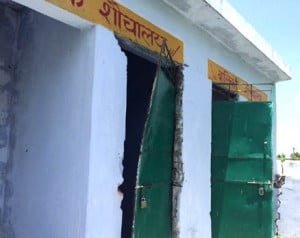In a new series of articles, Khabar Lahariya explores the implementation of the Swachh Bharat Mission in rural Uttar Pradesh. Prime Minister Narendra Modi’s flagship programme was announced on Independence Day last year and launched a few months later on 2 October. The programme has an urban and a rural component; while several crores have been sanctioned towards the programme, KL reports on how rural realities remain mostly unchanged as the first anniversary of this much publicized mission approaches.
 Mahoba. In Bundelkhand‘s Mahoba district, several schools have dysfunctional toilets (commodes piled high with bricks and cement, for example; or toilets with padlocks on the doors), a situation that has forced students to go out of the school premises looking for a spot in nearby fields to relieve themselves. ‘The primary school building is the most important public building in this village and yet the toilets are barely usable,’ said Surendra Shukla, the Assistant Teacher at the Daharra Primary School. ‘Not only are classes held here for close to a 100 students, the premises also houses the Aanganwadi (Day Care) Centre, the kitchen where mid day meals are prepared and serves as the Immunization Centre,’ he said. Kalidin, who works at the local stone quarry said that no new toilets had been passed for the village in at least the last 6 months. ‘A few households have pits that were dug but how does that qualify as a toilet? Would you be willing to use that? Besides, the depth of these pits is such that they’d fill up and be unusable after 4 – 6 months,’ he explained.
Mahoba. In Bundelkhand‘s Mahoba district, several schools have dysfunctional toilets (commodes piled high with bricks and cement, for example; or toilets with padlocks on the doors), a situation that has forced students to go out of the school premises looking for a spot in nearby fields to relieve themselves. ‘The primary school building is the most important public building in this village and yet the toilets are barely usable,’ said Surendra Shukla, the Assistant Teacher at the Daharra Primary School. ‘Not only are classes held here for close to a 100 students, the premises also houses the Aanganwadi (Day Care) Centre, the kitchen where mid day meals are prepared and serves as the Immunization Centre,’ he said. Kalidin, who works at the local stone quarry said that no new toilets had been passed for the village in at least the last 6 months. ‘A few households have pits that were dug but how does that qualify as a toilet? Would you be willing to use that? Besides, the depth of these pits is such that they’d fill up and be unusable after 4 – 6 months,’ he explained.
In Daharra, and every other village in Bundelkhand, a woman’s day begins with the selection of the spot she’ll use as a toilet, ‘I think it’s alright for women to go out [to defecate] only in the wee hours of the morning before most of the village rises,’ said Sundarkali. She said that she would defecate only early in the morning or late in the night. ‘It is too risky. What if someone from the village spots you?’
If entire villages are without toilets, the kasbas are no better. In Khanna kasba’s Dalit basti, there is no proper toilet for about 100 families that live there. ‘The Government launches one scheme after another but what’s the point if the poor can’t avail of these benefits?’ asked Siya. ‘Can you imagine how difficult it is to go find places in the fields during the monsoon and the winter seasons?’ added Anita.
Some kilometres away from the kasba, in Ghandua village the story is slightly different. Declared a Lohia village under the Lohia Samagra Gram Yojna, a scheme launched by the Samajwadi Party government in the state in 2012, the construction of 75 toilets had begun in the village, ‘These have come through the Lohia Gram Yojna. Under the scheme, each beneficiary family gets 1-2 sacks of cement, and bricks to dig a toilet 1 metre deep and erect walls. If the benefitting family pays an extra 900 rupees, they get a door as well,’ explained the pradhan, Ramkisun. ‘Before this there were no toilets here. We don’t know how effective these new toilets will be. Right now, they are distributing the raw material. Whether something will come of this or not remains to be seen,’ said Susheela, who is a resident of Ghandua.
A year of the Swachh Bharat Mission has concluded and the state of affairs in Mahoba provides a close-up view of the situation on the ground. According to the official website of the Mission, only 19.77% of the budget for the district has been used in the financial year 2014-15. Of this, no money was spent on providing toilets in schools, as is specifically mentioned in the Mission’s objectives. In the state of Uttar Pradesh, for the same period, only 30.1% of the entire budget was utilized. If one thought that the situation would improve as the Mission kicked in, it appears that for the current financial year, only 15.7% of the budget has been spent in Uttar Pradesh. What is more shocking is the fact that in a district like Mahoba, no funds have been utilized even though the eighth month of the year has begun. Currently, the district is sitting on an unspent 2 crores and 37 lakhs (23 million) rupees.
So is Swachh Bharat Mission simply its predecessor Nirmal Bharat Abhiyan with a new name and a shiny new face? It also calls into question implementation and accountability mechanisms for a Mission that has set itself up to change the fundamental living conditions of our rural and urban population.
Click here to read original Bundeli story